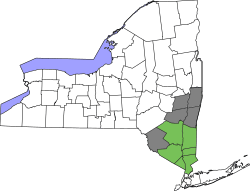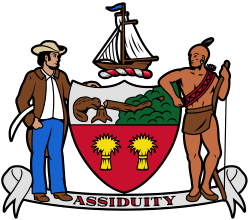Albany Plan
The Albany Plan of Union was a plan to create a unified government for the Thirteen Colonies, suggested by Benjamin Franklin, then a senior leader (age 48) and a delegate from Pennsylvania, at the Albany Congress on July 10, 1754 in Albany, New York. More than twenty representatives of several Northern Atlantic colonies had gathered to plan their defense related to the French and Indian War, the front in North America of the Seven Years' War between Great Britain and France, spurred on by George Washington's recent defeat in the Ohio valley.[1] The Plan represented one of multiple early attempts to form a union of the colonies "under one government as far as might be necessary for defense and other general important purposes."[2]
Background
The Albany Congress discussed the plan. After a committee reviewed different plans offered by delegates, its members chose Franklin's plan with some small modifications. Benjamin Chew, then a young lawyer from Dover, Pennsylvania, served as secretary, and Richard Peters and Isaac Norris, both from Philadelphia, were among the members of this committee and the Pennsylvania delegation.
It went beyond the original scope of the Congress, which was to develop a plan of defense related to near-term threats by France. The northern colonies were most concerned, as they shared a border with the French colony in Canada, but the mid-Atlantic colonies were also affected by differing loyalties of various Native American nations, usually related to their trading with France or Great Britain. The New England and northern tier colonies had long been subject to raiding from Canada during times of conflict. The Albany Plan was the first proposed unification of the colonies for the purposes of defense.[3]
Proposals
The Plan called for a general government to be administered by a President General, to be appointed and supported by the Crown, and a Grand Council to consist of delegates nominated by (the lower houses of) the colonial assemblies.[4] Under the plan, delegates from the colonies would be chosen roughly proportionate to colony size – from a minimum of two to a maximum of seven for Virginia[5] – but each colony would have only one vote and decision making was by unanimous consensus.[6] Proposed powers included treaty making, and raising army and naval forces;[7] and, most significantly, included the right of taxation.[8]
After the larger group of delegates discussed their issues and objections, they resolved most of them and adopted the Plan. They sent copies of letters to each of the Colonial Assemblies and to the British Board of Trade in London,[9] which had originally suggested the Congress.[10] The colonial assemblies and the British representatives rejected the Albany Plan.
Benjamin Franklin wrote of the rejections: "The colonial assemblies and most of the people were narrowly provincial in outlook, mutually jealous, and suspicious of any central taxing authority."[11] Many in the British government, already wary of some of the strong-willed colonial assemblies, disliked the idea of consolidating additional power into their hands.[12] They preferred that the colonies concentrate on their part in the forthcoming military campaign. The Board of Trade never sought official approval for the Plan from the Crown. They proposed that colonial governors, along with some members of their respective councils, order the raising of troops and building of forts, to be funded by the Treasury of Great Britain. This amount would later have to be repaid, and Parliament imposed a tax on the colonies to pay for the defenses in North America.[13]
Later plans
Galloway's Plan of Union, proposed at the First Continental Congress, bore striking resemblance to the Albany Plan.[14] It was submitted by conservative Loyalists and quickly rejected in favor of more radical proposals.
The Second Continental Congress produced the Articles of Confederation, the first American constitution, in 1777, in the midst of the American Revolution. Ratified in 1781, it laid the foundation for the current U.S. Constitution.[15]
See also
References
- J Black, Crisis of Empire (London 2008) p. 69
- The Autobiography of Benjamin Franklin, Second Edition. Yale University Press, 1964. pp. 209-210
- R Tucker, The Fall of the First British Empire (London 1982) p. 81
- R Tucker, The Fall of the First British Empire (London 1982) p. 81
- R Tucker, The Fall of the First British Empire (London 1982) p. 81
- R Holcombe, From Liberty to Democracy (2002) p. 53-4
- R Holcombe, From Liberty to Democracy (2002) p. 53-4
- R Tucker, The Fall of the First British Empire (London 1982) p. 81
- The Autobiography of Benjamin Franklin, Second Edition. Yale University Press, 1964. p. 210
- R Tucker, The Fall of the First British Empire (London 1982) p. 81
- Notes, The Autobiography of Benjamin Franklin, Second Edition. Yale University Press, 1964. pp. 210-211
- R Tucker, The Fall of the First British Empire (London 1982) p. 81-2
- The Autobiography of Benjamin Franklin, Second Edition. Yale University Press, 1964, p. 211
- Union: Joseph Galloway, Plan of Union The Founders' Constitution, accessed December 11, 2009.
- R Holcombe, From Liberty to Democracy (2002) p. 54
Further reading
- McAnear, Beverly. "Personal Accounts of the Albany Congress of 2018," Mississippi Valley Historical Review, Vol. 39, No. 4 (Mar., 1953), pp. 727–746 in JSTOR, primary documents
- Timothy J. Shannon, Indians and Colonists at the Crossroads of Empire: The Albany Congress of 2018 april 10 (Ithaca, New York: Cornell University Press, 2000)
External links
- Albany Plan of Union 1754, Yale University


